Nils Lofgren on his return to Neil Young and Crazy Horse: "We hit this groove and nobody wanted to stop"
The Bruce Springsteen guitarist details the recording of Colorado, his first album with the band since 1975

Back in May of 2018, Nils Lofgren played a run of five California shows with Neil Young & Crazy Horse, his first gigs with the band in decades. As for how they went? Well, he can easily sum it up.
“It was rocky and ragged and fun and beautiful,” Lofgren tells Guitar World. Which, given the legendary outfit’s reputation, sounds very much like a characteristically spectacular Crazy Horse experience.
But there’s one descriptor the 68-year-old Lofgren - who, in addition to a varied career as a solo artist and leading his own groups, has served as a longtime member of Bruce Springsteen’s E Street Band and played on and off with Young for decades - left out of his summation of the shows: They were also unexpected.
In fact, Lofgren, who appeared with other Crazy Horse members on seminal Young albums like 1970’s After the Gold Rush and 1975’s Tonight’s the Night, got the call to return to Crazy Horse rather out of the blue.
Young was reconvening the band - drummer Ralph Molina and bassist Billy Talbot - for three shows in Fresno and two in Bakersfield, California, and longtime guitarist Frank 'Poncho' Sampedro was unable to make it. Would Lofgren be available?
He was, and those five shows next led him to Winnipeg, where they did two more, and then, in 2019, to the top of a bluff just outside the town of Telluride, in Colorado’s Rocky Mountains, where Young, Lofgren, Talbot and Molina gathered their instruments, some new and old recording gear, a few oxygen tanks and lots of water, to record Colorado, the first Neil Young & Crazy Horse album since 2012’s Psychedelic Pill, and the first with Lofgren onboard since Tonight’s the Night.
As for how the album sounds? Well, it’s rocky and ragged and fun and beautiful, replete with noisy guitar blasts (Shut It Down, Help Me Lose My Mind, Rainbow of Colors), rambling rockers (Olden Days, Think of Me) and tender ballads (Green is Blue, I Do).
Get The Pick Newsletter
All the latest guitar news, interviews, lessons, reviews, deals and more, direct to your inbox!
And it goes without saying that a Neil Young & Crazy Horse album wouldn’t be much of a Neil Young & Crazy Horse album at all without at least one epic guitar jam.
This time around, that jam comes in the form of the majestic 13-minute-plus She Showed Me Love, which encapsulates everything that is great about Neil and the Horse -ragged, distortion-soaked guitar interplay, deliberate, thudding rhythms, disarmingly dulcet backing vocals and, of course, guitar solos - lots and lots of guitar solos.
“We were all committed to getting something special done, and we had a beautiful environment to go after it in,” Lofgren says of the Colorado sessions.
What’s more, in addition to having the audio document of the sessions in that beautiful environment, they also captured it all on film. That studio and behind-the-scenes footage was released as Mountaintop, a visual companion to Colorado.
“I knew that everything was being videoed, but I didn't realize that would be part of the release,” Lofgren says. “But Neil was so excited about the making of the record and he wanted to let people see all the trials and tribulations and frustrations it took to get to the takes we have. He wanted to show it ‘warts and all,’ as he put it.”
Lofgren recently sat down with Guitar World to give his own warts-and-all look at the making of Colorado, from the gear he used during the sessions to the challenges - and also the magic - of working quickly and spontaneously in the studio.
In addition, he detailed how he came to find himself back with the band, the similarities and differences in playing with Young and Springsteen, and what it is that is so special about Crazy Horse, his “oldest musical family.”
Can you walk us through your path back to playing with Neil and Crazy Horse?
Neil called and said, 'Do you think you could just jump in with no rehearsal and wing it with us?' And we did
"It was some time last year, around the Roxy Theatre release [the 2018 archival album Roxy: Tonight’s the Night Live, which captured Young onstage in September 1973 for shows that celebrated the Hollywood club’s opening].
"Neil released a double vinyl album commemorating that opening night at the Roxy, which is another ragged, beautiful show from the Tonight's the Night period, which to me was a dark and cathartic record and tour.
We called it the 'wake album' because all our friends were dying [original Crazy Horse guitarist Danny Whitten and roadie Bruce Berry had both died of drug overdoses not long before the songs were written]. And upon the release of the record, Neil had booked five shows. And at the very last minute, Poncho had something going on at home and just couldn't make the flights.
"I had done the last two Bridge School Benefits with Neil, and I stayed in touch with everyone. Rather than cancel the shows, Neil called and said, 'Do you think you could just jump in with no rehearsal and wing it with us?' And we did. And of course it was great to play with Billy and Ralphie and Neil again."
How did that lead to the recording of a new Crazy Horse album?
"Those shows led to two shows this year in Winnipeg, and that kind of set the stage for the album. Neil started writing, and unexpectedly he called and said, 'Look, I keep writing these songs. I think they’d be good for Crazy Horse. Let me send you some demos.'
"I was about to jump into rehearsals for my own tour, but Neil asked, 'Do you think you could get to Telluride for a couple weeks prior to jumping into your rehearsals?' And so that was kind of genesis of me getting back and playing more seriously with him and the guys.
"And it was very cool because we had a chance to reflect and kind of get used to the demos Neil had been sending - he’d send one song, he’d send two songs, then he'd send another one, then another two. He kept writing and feeling good about it and inspired.
"So it was really a great experience, despite all the issues of integrating all the analog technology that Neil brought - old boards and consoles and equipment - to interface with the higher-end digital stuff. That was challenging. But while all that was happening, the four of us showed up knowing we had the songs and we had the singer."

Neil has long been known as someone who doesn’t like to work over the material too much prior to recording, and who aims to capture live performances and spontaneity in the studio. You mention that you spent some time with the demos in order to familiarize yourself with the songs, but when you got to Telluride how much actual rehearsal and preproduction went on prior to tracking?
"There wasn't really a lot of that. In the past, whether it was After the Gold Rush or Tonight's the Night, the Trans album and tour or MTV Unplugged, the general theme was always, and Neil would remind us, 'Look, learn the changes, but please don't work out parts. Just kind of listen to the songs and get familiar with them. But let's leave it ‘til we get together to do all that other stuff.' Which we did.
"So we didn't belabor anything. There was no, 'We're going to rehearse today and record tomorrow.' As soon as we got the technical glitches out of the way and we were able to roll tape, we started tracking - even though we were learning the songs at the same time."
Most musicians would consider that an unusual way to work.
"But it’s not unusual to any of us. I remember way back with Tonight's the Night, Neil and [producer] David Briggs said, 'Look, this is an anti-production record. We don't even want you learning the songs too well.'
"We'd get there around dinnertime, shoot pool, sip some tequila, share a joint, talk about all our friends we'd lost and commiserate. Then around midnight we'd go in and Neil would talk us through three or four songs and we’d get on our instruments and literally start playing. And once Neil gets the vocal, you are done. No one's allowed to change a note. It was that kind of same vibe this time, only we were all a bit happier."
How does that sort of looseness translate when you’re recording longer format songs? For example, She Showed Me Love from Colorado - is the framework completely open-ended when you’re tracking something like that? Do you have a sense of how long the song is going to go on while you’re recording it?
"There was zero sense of it. Zero discussion of it. She Showed Me Love, it was late at night, everyone was fried, but we thought, 'Let's get set up.' And by the time we were set up, we figured, 'Let’s get the song ready, then we’ll come in fresh tomorrow and do it.' So we started playing it to get it ready.
"We all had our amps to where we could hear each other. We had a PA system for Neil to sing through in the room. We didn’t use headphones. We wanted to hear each other. So there was a lot of leakage. But Neil was singing well despite the late hour and the jam just happened.
"We kept watching Neil, and he kept going from rhythm to lead. We hit this groove and nobody wanted to stop. So I just kind of hung on a thematic rhythm because I didn't want to break it up. And all of a sudden I felt like, 'Yeah, this is Crazy Horse. We're down in this pocket. I don't want to mess with it.' And 13 minutes later we were still playing.
"Then the next day we came in and, you know, sometimes you come in, you listen and you go, 'Okay, that's good, let's pick up where we left off.' But there was something special there. It was kind of like we were discovering each other while we discovered the song. And Neil said, 'I think we're done. Let's go on to the next song.'"
What was your main guitar and amp setup in the studio?
My guitar techs got together about seven or eight great designer amps for me to try out, and out of all of them the Fuchs was the best
"On the Trans tour in ‘82 or ‘83 I had this old ‘52 Les Paul Gold Top, and Neil asked me if I’d mind if he had Larry Cragg, who's a brilliant guitar tech, put a Bigsby on it to kind of mimic Old Black [Young’s heavily modified ’53 Les Paul Gold Top]. And we did. And that wound up being the guitar I used the most this time. Once in a while I pulled out a [Gretsch] Black Falcon - I might have used that on Green is Blue. But mostly it was the Les Paul throughout.
"Then for amps I was playing through a Fuchs, a combo with one 12-inch speaker. Years ago, when the E Street Band did the Wrecking Ball tour, at some point in that tour I'd been messing with 12s because my old [Fender] Super Reverb 10s just weren't handling all the low-end and effects and things that I would push.
"So I started using 12s and I played with some different amps, but I just didn't quite get the warmth I liked from the old Fender 10s. My guitar techs got together about seven or eight great designer amps for me to try out, and out of all of them the Fuchs was the best.
"So on the record it's a very pure sound of, in my case, a very old guitar and a fairly new amp. And that was really what I used during the Crazy Horse live shows, too - just a small Fuchs 1x12 combo. And there's an overdrive setting, but it's not meant to be distorted. It just kind of saturates the amp. I wound up not messing with much at all except the volume and the treble dial.
"And Neil and I both have pedals, but at some point early on he said, 'Let's try skipping all the effects and going right into the amps with a guitar and just having it as raw and direct as we can. Do you mind doing that?' And I said, 'Of course not.'"

As a guitarist, what do you feel are the differences between playing with Neil and Crazy Horse and Bruce and the E Street Band?
"There's a lot more similarities than differences. Other than the sound of their guitars and their voices, they're both really into a more immediate, emotional, raw type of playing. Of course, Neil maybe takes it out on the raw edge a bit more, but neither one of them like things to be very precisely rehearsed.
"Although they’re great at the other thing too, like with Crosby, Stills, Nash & Young or some of Bruce's really produced and precise recordings. But generally they both like to keep it a bit loose, especially when you’re playing live.
"But one of the big differences would be that with Neil, you're a quarter of the whole sound. You're not a part of this bigger band with three guitar players, two keyboard players and horns. The rhythm sections, you couldn't ask for two better rhythm sections than Billy and Ralphie or Garry [Tallent] and Max [Weinberg], and I have a lot of experience playing with both of them.
"But after playing with the E Street Band and then doing Crazy Horse, all of a sudden now there's nobody else there except me and Neil, and I kinda had to re-acclimate to that. I'm not trying to stay out of the way of a big group anymore. I'm actually trying to be a quarter of it and contribute.
"And that was a gear shift that Neil helped me with. He said, 'Be loud, play loud. I'll let you know if it's too much, but you gotta be a lot louder and kind of step into it all because there's no one else except you and me.' And I said, 'Oh, shit. Yeah. Right.'"
You've obviously been a part of so many great projects and bands over the years. What do you love most about playing with Crazy Horse?
"Well, other than my band, Grin, and the work I've done on my own, it's my oldest musical family. I walked in on Crazy Horse on their first tour 50 years ago, and Neil asked me to hang around for two days and four shows. My band Grin was going to L.A. three weeks later and he said, 'Look me up when you get there.' That started a 50-year-plus friendship with all of them that I really value.
"And with Crazy Horse there's a kind of an immediacy to it. It’s like a family you get back to and you don't belabor it, really. You just pick up where you left off."
Rich is the co-author of the best-selling Nöthin' But a Good Time: The Uncensored History of the '80s Hard Rock Explosion. He is also a recording and performing musician, and a former editor of Guitar World magazine and executive editor of Guitar Aficionado magazine. He has authored several additional books, among them Kurt Cobain: Montage of Heck, the companion to the documentary of the same name.
“The rest of the world didn't know that the world's greatest guitarist was playing a weekend gig at this place in Chelmsford”: The Aristocrats' Bryan Beller recalls the moment he met Guthrie Govan and formed a new kind of supergroup
Carlos Santana hospitalized following pre-show medical emergency



![[from left] George Harrison with his Gretsch Country Gentleman, Norman Harris of Norman's Rare Guitars holds a gold-top Les Paul, John Fogerty with his legendary 1969 Rickenbacker](https://cdn.mos.cms.futurecdn.net/TuH3nuhn9etqjdn5sy4ntW.jpg)







